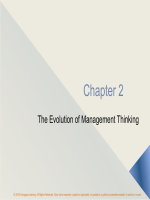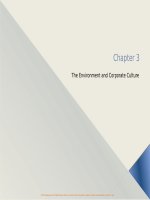Management 12e by w griffin ch11
Bạn đang xem bản rút gọn của tài liệu. Xem và tải ngay bản đầy đủ của tài liệu tại đây (1.75 MB, 34 trang )
TWELFTH EDITION
MANAGEMENT
Ricky W. Griffin
Part Four: The
Organizing Process
Chapter Eleven: Managing
Organization Design
© 2017 Cengage Learning. All rights reserved. May not be copied, scanned, or duplicated, in whole or in part, except for use as permitted
in a license distributed with a certain product or service or otherwise on a password-protected website for classroom use.
11 - 1
Learning Outcomes
1. Describe the basic nature of organization design.
2. Identify and explain two basic universal
perspectives on organization design.
3. Identify and explain key situational influences on
organization design.
4. Discuss how an organization’s strategy and its
design are interrelated.
5. Describe the basic forms of organization design.
6. Describe emerging issues in organization design.
© 2017 Cengage Learning. All rights reserved. May not be copied, scanned, or duplicated, in whole or in part, except for use as permitted
in a license distributed with a certain product or service or otherwise on a password-protected website for classroom use.
11 - 2
Nature of Organization Design
Organization design
– is the overall set of structural elements and the
relationships among those elements used to
manage the total organization.
Keep two important points in mind.
– Organizations are not designed and left intact
• most change continuously.
– Organization design for larger organizations is
extremely complex
• no description is complete.
© 2017 Cengage Learning. All rights reserved. May not be copied, scanned, or duplicated, in whole or in part, except for use as permitted
in a license distributed with a certain product or service or otherwise on a password-protected website for classroom use.
11 - 3
Universal Perspectives on Organization
Design
Bureaucratic Model (Max Weber)
– A bureaucracy is an organization based on a
legitimate and formal system of authority.
– Weber’s ideal bureaucracy’s characteristics:
•
•
•
•
•
Distinct division of labor.
Consistent rules and uniform task performance.
A chain of command from top to bottom.
Impersonal managers.
Employment based on technical expertise.
© 2017 Cengage Learning. All rights reserved. May not be copied, scanned, or duplicated, in whole or in part, except for use as permitted
in a license distributed with a certain product or service or otherwise on a password-protected website for classroom use.
11 - 4
Bureaucratic Model
Strengths
Weaknesses
Several elements
often improve
efficiency.
Helps prevent
favoritism.
Makes procedures
and practices clear to
everyone.
Results in inflexibility
and rigidity.
Making exceptions or
changing the rules is
often difficult.
Often results in
neglect of human and
social processes.
© 2017 Cengage Learning. All rights reserved. May not be copied, scanned, or duplicated, in whole or in part, except for use as permitted
in a license distributed with a certain product or service or otherwise on a password-protected website for classroom use.
11 - 5
Behavioral Model
The behavioral model
– stresses attention to developing work groups
and concern with interpersonal processes.
• Eight important processes fall along a continuum:
o leadership, motivation, communication, interactions,
decision making, goal setting, control, and performance
goals.
• A System 1 design anchors one end of the
continuum; similar to the bureaucratic model.
• A System 4 design anchors the other end of the
continuum, similar to the behavioral model.
© 2017 Cengage Learning. All rights reserved. May not be copied, scanned, or duplicated, in whole or in part, except for use as permitted
in a license distributed with a certain product or service or otherwise on a password-protected website for classroom use.
11 - 6
Table 11.1
System 1 and System 4 Organizations
Source: Adapted from Rensis Likert, The Human Organization, 1967. Copyright © 1967 The McGraw-Hill Companies, Inc. Reprinted with permission.
© 2017 Cengage Learning. All rights reserved. May not be copied, scanned, or duplicated, in whole or in part, except for use as permitted
in a license distributed with a certain product or service or otherwise on a password-protected website for classroom use.
11 - 7
Behavioral Model
Major Strength
It emphasizes human
behavior by stressing
the value of an
organization’s
employees.
– This led to a more
humanistic approach to
designing organizations.
Major Weakness
The approach again
argues there is one
best way to design an
organization – as a
System 4.
– Evidence is strong there
is no one best approach.
© 2017 Cengage Learning. All rights reserved. May not be copied, scanned, or duplicated, in whole or in part, except for use as permitted
in a license distributed with a certain product or service or otherwise on a password-protected website for classroom use.
11 - 8
Situational Influences on Organization
Design
Situational view of organization design
– assumes the optimal design depends on a set
of relevant situational factors.
– Four basic factors are discussed here
• technology, environment, size, and organization life
cycle.
– Another factor, strategy, is covered in the next
section.
© 2017 Cengage Learning. All rights reserved. May not be copied, scanned, or duplicated, in whole or in part, except for use as permitted
in a license distributed with a certain product or service or otherwise on a password-protected website for classroom use.
11 - 9
Organization Design and Technology
Technology is the conversion processes
used to transform inputs into outputs.
– Multiple technologies may be used but the most
important one is called the core technology.
– Joan Woodward identified three forms of
technology.
• Unit or small-batch.
• Large-batch or mass-production.
• Continuous-process.
© 2017 Cengage Learning. All rights reserved. May not be copied, scanned, or duplicated, in whole or in part, except for use as permitted
in a license distributed with a certain product or service or otherwise on a password-protected website for classroom use.
11 - 10
Organization Design and Technology
Woodward’s findings
– Different organization designs associate with each
technology.
– With increased complexity comes
• increased levels of management, executive span of
management and relative size of staff.
– At a general level.
• Extreme technologies similar to System 4s and middle
range like System 1s.
• The middle range had more specialization.
• Success depended on how the organization followed the
typical pattern.
© 2017 Cengage Learning. All rights reserved. May not be copied, scanned, or duplicated, in whole or in part, except for use as permitted
in a license distributed with a certain product or service or otherwise on a password-protected website for classroom use.
11 - 11
Organization Design and Environment
• Similar to a System 1 model,
most frequently found in stable
environments.
• Structured in predictable ways.
• A very flexible and informal
model, most often found in
unstable environments.
• Constant change dictates a high
level of flexibility.
Mechanistic organization
Organic organization
Burns and Stalker studied stable and unstable
environments and two design styles emerged.
© 2017 Cengage Learning. All rights reserved. May not be copied, scanned, or duplicated, in whole or in part, except for use as permitted
in a license distributed with a certain product or service or otherwise on a password-protected website for classroom use.
11 - 12
Organization Design and Environment
Differentiation
• The extent to which the organization is broken down
into subunits.
Integration
• The degree to which the various subunits must work
together in a coordinated fashion.
Lawrence and Lorsch believed this influence varies between
units of the same organization and characterized two primary
dimensions.
© 2017 Cengage Learning. All rights reserved. May not be copied, scanned, or duplicated, in whole or in part, except for use as permitted
in a license distributed with a certain product or service or otherwise on a password-protected website for classroom use.
11 - 13
Organization Design and Organizational
Size
Organizational size
– is the total number of full-time or full-timeequivalent employees.
– Researchers from the University of Aston used
a wider array of organizations than Woodward.
• Technology influences structure in small firms but
the link breaks down in larger firms.
• Larger firms have more job specialization, standard
operating procedures, rules and regulations, and a
greater degree of decentralization.
© 2017 Cengage Learning. All rights reserved. May not be copied, scanned, or duplicated, in whole or in part, except for use as permitted
in a license distributed with a certain product or service or otherwise on a password-protected website for classroom use.
11 - 14
Organization Design and Organizational
Life Cycle
Organizational life cycle
– is a four-phase process through which
organizations evolve.
– Stages include:
•
•
•
•
Birth – the start of the business.
Youth – growth.
Midlife – gradual growth into stability.
Maturity – stability into possible decline.
– Structure must evolve to cope with challenges
in each stage of the process.
© 2017 Cengage Learning. All rights reserved. May not be copied, scanned, or duplicated, in whole or in part, except for use as permitted
in a license distributed with a certain product or service or otherwise on a password-protected website for classroom use.
11 - 15
Strategy and Organization Design
Corporate-level strategy
– Choices will partially determine design.
• A single-product strategy – functional
departmentalization and mechanistic design.
• Related diversification – requires a high level of
coordination.
• Unrelated diversification – hierarchical reporting
system.
© 2017 Cengage Learning. All rights reserved. May not be copied, scanned, or duplicated, in whole or in part, except for use as permitted
in a license distributed with a certain product or service or otherwise on a password-protected website for classroom use.
11 - 16
Strategy and Organization Design
Business-level strategy
– Directly influence organization design.
• A defender strategy – tall and centralized.
• A prospector strategy – flat and decentralized.
• An analyzer strategy – lies in the middle.
Organizational functions
– Less obvious and usually covered under
corporate or business-level concerns.
• Involves marketing, finance, production, HR, etc.
© 2017 Cengage Learning. All rights reserved. May not be copied, scanned, or duplicated, in whole or in part, except for use as permitted
in a license distributed with a certain product or service or otherwise on a password-protected website for classroom use.
11 - 17
Basic Forms of Organization Design
Functional
(U-Form)
Conglomerate
(H-Form)
Matrix
Divisional
(M-Form)
Hybrid
Most designs fall into one of four basic
categories, others are hybrids.
© 2017 Cengage Learning. All rights reserved. May not be copied, scanned, or duplicated, in whole or in part, except for use as permitted
in a license distributed with a certain product or service or otherwise on a password-protected website for classroom use.
11 - 18
Basic Forms of Organization Design
Functional (U-Form) design
– is based on the functional approach to
departmentalization. (U for unitary.)
– Units are grouped into functional departments.
– Considerable coordination is needed.
– Shares same advantages/disadvantages as
functional departmentalization.
• Staffed by experts, facilitates coordination, but
promotes a functional focus and centralization.
© 2017 Cengage Learning. All rights reserved. May not be copied, scanned, or duplicated, in whole or in part, except for use as permitted
in a license distributed with a certain product or service or otherwise on a password-protected website for classroom use.
11 - 19
Figure 11.1
Functional or U-Form Design for a Small
Manufacturing Company
Note that each functional area is
dependent on the others.
© 2017 Cengage Learning. All rights reserved. May not be copied, scanned, or duplicated, in whole or in part, except for use as permitted
in a license distributed with a certain product or service or otherwise on a password-protected website for classroom use.
11 - 20
Basic Forms of Organization Design
Conglomerate (H-Form) design
– used by an organization made up of a set of
unrelated businesses.
– Essentially a holding company results from
unrelated diversification. (H for holding.)
– A general manager oversees each business.
• Responsible for profit/loss, acts independently.
– Corporate staff evaluate, allocate, and decide.
– Basic shortcomings are complexity.
© 2017 Cengage Learning. All rights reserved. May not be copied, scanned, or duplicated, in whole or in part, except for use as permitted
in a license distributed with a certain product or service or otherwise on a password-protected website for classroom use.
11 - 21
Figure 11.2
Conglomerate (H-Form) Design at Samsung
This design results from a strategy of
unrelated diversification.
© 2017 Cengage Learning. All rights reserved. May not be copied, scanned, or duplicated, in whole or in part, except for use as permitted
in a license distributed with a certain product or service or otherwise on a password-protected website for classroom use.
11 - 22
Basic Forms of Organization Design
Divisional (M-Form) design
– multiple businesses in related areas operating
within a larger organizational framework.
• (M-form for multidivisional.)
– Some activities are decentralized, some are
centralized at the corporate level.
– The biggest advantage is the opportunity for
coordination and shared resources.
– If kept in balance, outperforms U- or H-forms.
© 2017 Cengage Learning. All rights reserved. May not be copied, scanned, or duplicated, in whole or in part, except for use as permitted
in a license distributed with a certain product or service or otherwise on a password-protected website for classroom use.
11 - 23
Figure 11.3
Multidivisional (M-Form) Design at Hilton Hotels
This design results from a strategy of
related diversification.
© 2017 Cengage Learning. All rights reserved. May not be copied, scanned, or duplicated, in whole or in part, except for use as permitted
in a license distributed with a certain product or service or otherwise on a password-protected website for classroom use.
11 - 24
Basic Forms of Organization Design
Matrix design
– is based on two overlapping bases of
departmentalization.
– Project managers head a project group
composed of representatives from functional
departments.
– A multiple-command structure results when an
individual reports to a functional superior and
to one or more project managers.
© 2017 Cengage Learning. All rights reserved. May not be copied, scanned, or duplicated, in whole or in part, except for use as permitted
in a license distributed with a certain product or service or otherwise on a password-protected website for classroom use.
11 - 25









